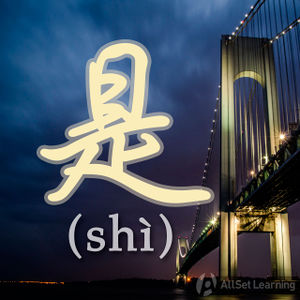Difference between revisions of "Connecting nouns with "shi""
m (Text replace - "(\r?\n){2}" to "\r\n") |
|||
| Line 1: | Line 1: | ||
| − | {{Grammar Box}} | + | {{Grammar Box}} |
| + | |||
| + | The verb ''to be'' is not used in Chinese the same way as it is in English. In Chinese, 是 (shì) is for connecting [[nouns]], and is generally not used with [[adjectives]]. | ||
| + | |||
| + | == Structure == | ||
| + | |||
| + | The structure for connecting nouns with 是 is: | ||
| + | |||
| + | <div class="jiegou"> | ||
| + | |||
| + | Noun 1 + 是 + Noun 2 | ||
| + | |||
| + | </div> | ||
| + | |||
| + | This is equivalent to "Noun 1 '''is''' Noun 2" in English. | ||
| + | |||
| + | Chinese does not [http://en.wikipedia.org/wiki/Grammatical_conjugation conjugate] verbs. That is, the form of the verb is the same no matter who is doing it. In this case, it is always 是 and never changes. As you can see, it's easy to form simple sentences expressing ''to be'' in Chinese. | ||
| + | |||
| + | == Examples == | ||
| + | |||
| + | <div class="liju"> | ||
| + | |||
| + | * <strong>我</strong> <em>是</em> <strong>学生</strong>。<span class="trans">I am a student.</span> | ||
* <strong>她</strong> <em>是</em> <strong>医生</strong>。<span class="trans">She is a doctor.</span> | * <strong>她</strong> <em>是</em> <strong>医生</strong>。<span class="trans">She is a doctor.</span> | ||
* <strong>他</strong> <em>是</em> <strong>老师</strong>。<span class="trans">He is a teacher.</span> | * <strong>他</strong> <em>是</em> <strong>老师</strong>。<span class="trans">He is a teacher.</span> | ||
| Line 8: | Line 30: | ||
* <strong>那</strong> <em>是</em> <strong>你的礼物</strong>。<span class="trans">This is your gift.</span> | * <strong>那</strong> <em>是</em> <strong>你的礼物</strong>。<span class="trans">This is your gift.</span> | ||
* <strong>这</strong> <em>是</em> <strong>我的衣服</strong>。<span class="trans">That is my clothes.</span> | * <strong>这</strong> <em>是</em> <strong>我的衣服</strong>。<span class="trans">That is my clothes.</span> | ||
| − | * <strong>你</strong> <em>是</em> <strong>我的朋友</strong>。<span class="trans">You are my friend.</span> | + | * <strong>你</strong> <em>是</em> <strong>我的朋友</strong>。<span class="trans">You are my friend.</span> |
| − | * [[Simple "noun + adjective" sentences]] | + | |
| + | </div> | ||
| + | |||
| + | Be careful though. As you can see above, 是 is only used to link two nouns. It cannot be used to link a noun and an adjective. This is a very common mistake for people just beginning to learn Chinese. For that kind of sentence, you'll want to use [[Simple "noun + adjective" sentences|the linking word 很]]. | ||
| + | |||
| + | ==See also== | ||
| + | |||
| + | * [[Word order]] | ||
| + | * [[Simple "noun + adjective" sentences]] | ||
| + | |||
| + | == Sources and further reading == | ||
| + | |||
| + | * [[Integrated Chinese: Level 1, Part 1 (3rd ed)]] (pp. 29) [http://www.amazon.com/gp/product/0887276385/ref=as_li_ss_tl?ie=UTF8&tag=allset-20&linkCode=as2&camp=217145&creative=399369&creativeASIN=0887276385 →buy] | ||
* [[Chinese: An Essential Grammar, Second Edition]] (pp. 47-8) [http://www.amazon.com/gp/product/0415372615/ref=as_li_ss_tl?ie=UTF8&tag=allset-20&linkCode=as2&camp=217145&creative=399369&creativeASIN=0415372615 →buy] | * [[Chinese: An Essential Grammar, Second Edition]] (pp. 47-8) [http://www.amazon.com/gp/product/0415372615/ref=as_li_ss_tl?ie=UTF8&tag=allset-20&linkCode=as2&camp=217145&creative=399369&creativeASIN=0415372615 →buy] | ||
* [[New Practical Chinese Reader 1 (新实用汉语课本1)]] (pp. 44) [http://www.amazon.com/gp/product/7561910401/ref=as_li_ss_tl?ie=UTF8&tag=allset-20&linkCode=as2&camp=217145&creative=399369&creativeASIN=7561910401 →buy] | * [[New Practical Chinese Reader 1 (新实用汉语课本1)]] (pp. 44) [http://www.amazon.com/gp/product/7561910401/ref=as_li_ss_tl?ie=UTF8&tag=allset-20&linkCode=as2&camp=217145&creative=399369&creativeASIN=7561910401 →buy] | ||
* [[New Practical Chinese Reader 1 (新实用汉语课本1)(2nd ed)]] (pp. 50-1) [http://www.amazon.com/gp/product/7561926235/ref%3das_li_ss_tl?ie=UTF8&tag=allset-20&linkCode=as2&camp=217145&creative=399373&creativeASIN=7561926235 →buy] | * [[New Practical Chinese Reader 1 (新实用汉语课本1)(2nd ed)]] (pp. 50-1) [http://www.amazon.com/gp/product/7561926235/ref%3das_li_ss_tl?ie=UTF8&tag=allset-20&linkCode=as2&camp=217145&creative=399373&creativeASIN=7561926235 →buy] | ||
| − | *[[40 Lessons for Basic Chinese Course (基础汉语40课上册)]] (p. 62)[http://www.amazon.com/gp/product/B001FTL8D8/ref=as_li_ss_tl?ie=UTF8&camp=1789&creative=390957&creativeASIN=B001FTL8D8&linkCode=as2&tag=allset-20 →buy] | + | *[[40 Lessons for Basic Chinese Course (基础汉语40课上册)]] (p. 62)[http://www.amazon.com/gp/product/B001FTL8D8/ref=as_li_ss_tl?ie=UTF8&camp=1789&creative=390957&creativeASIN=B001FTL8D8&linkCode=as2&tag=allset-20 →buy] |
| + | |||
| + | [[Category:A1 grammar points]] | ||
{{Basic Grammar|是|A1|A + 是 + B|我 <em>是</em> 学生 。|grammar point|ASGUN7RX}} | {{Basic Grammar|是|A1|A + 是 + B|我 <em>是</em> 学生 。|grammar point|ASGUN7RX}} | ||
{{Similar|Word order}} | {{Similar|Word order}} | ||
Revision as of 09:12, 26 November 2013
-
Level
-
Similar to
-
Used for
-
Keywords
The verb to be is not used in Chinese the same way as it is in English. In Chinese, 是 (shì) is for connecting nouns, and is generally not used with adjectives.
Structure
The structure for connecting nouns with 是 is:
Noun 1 + 是 + Noun 2
This is equivalent to "Noun 1 is Noun 2" in English.
Chinese does not conjugate verbs. That is, the form of the verb is the same no matter who is doing it. In this case, it is always 是 and never changes. As you can see, it's easy to form simple sentences expressing to be in Chinese.
Examples
- 我 是 学生。I am a student.
- 她 是 医生。She is a doctor.
- 他 是 老师。He is a teacher.
- 这 是 书。This is a book.
- 那 是 杯子。That is a cup.
- 她 是 我 的 老板。She is my boss.
- 这 些 是 红玫瑰。
- 那 是 你的礼物。This is your gift.
- 这 是 我的衣服。That is my clothes.
- 你 是 我的朋友。You are my friend.
Be careful though. As you can see above, 是 is only used to link two nouns. It cannot be used to link a noun and an adjective. This is a very common mistake for people just beginning to learn Chinese. For that kind of sentence, you'll want to use the linking word 很.
See also
Sources and further reading
- Integrated Chinese: Level 1, Part 1 (3rd ed) (pp. 29) →buy
- Chinese: An Essential Grammar, Second Edition (pp. 47-8) →buy
- New Practical Chinese Reader 1 (新实用汉语课本1) (pp. 44) →buy
- New Practical Chinese Reader 1 (新实用汉语课本1)(2nd ed) (pp. 50-1) →buy
- 40 Lessons for Basic Chinese Course (基础汉语40课上册) (p. 62)→buy



